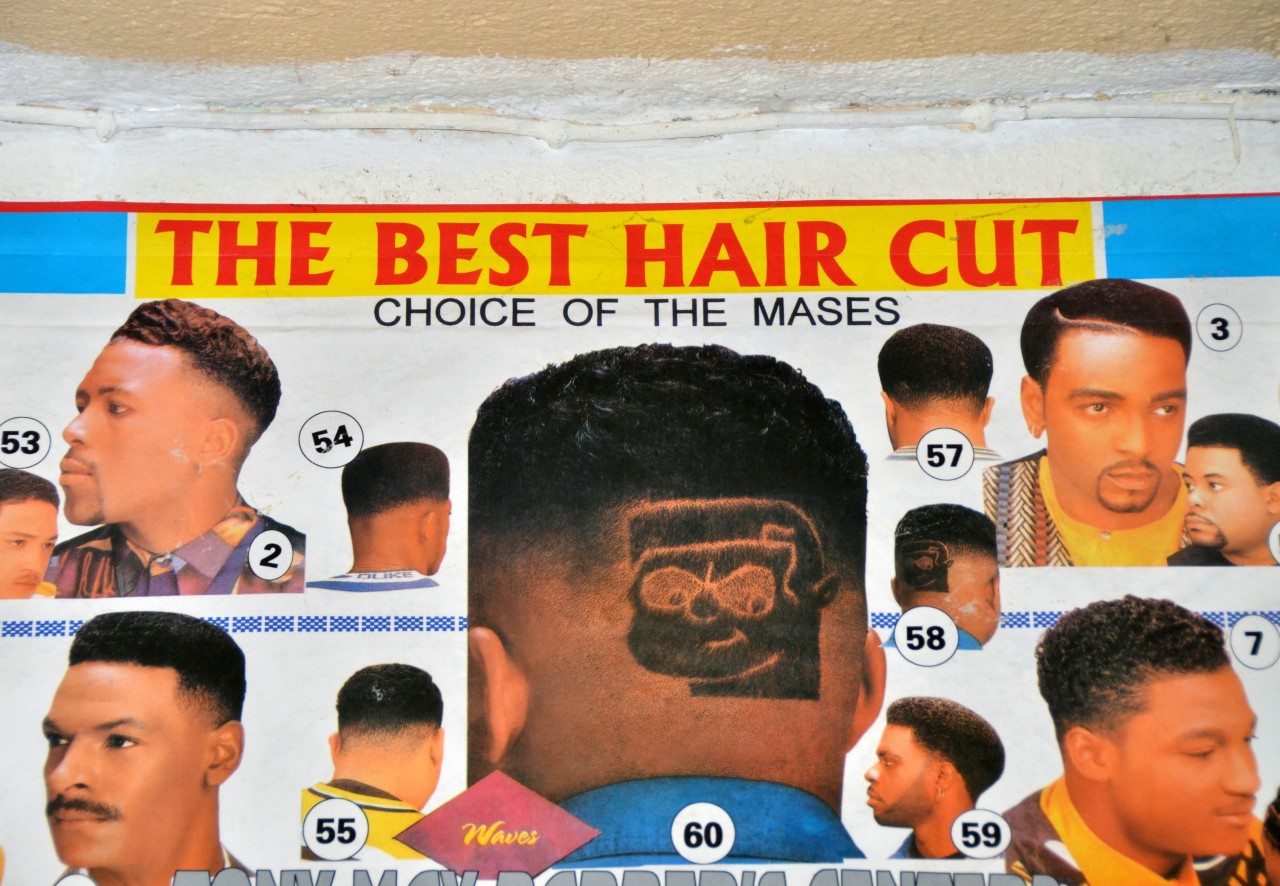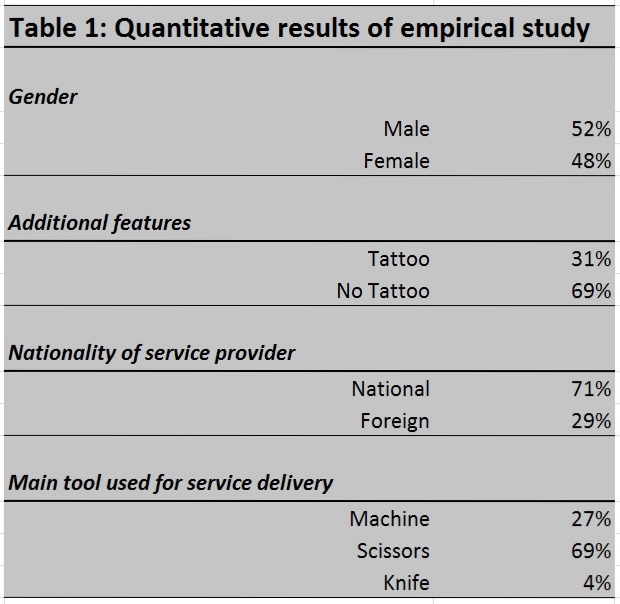Abstract
After years of hard work, I am pleased to present the results of an extensive empirical study on exports of services and related imports of goods: The Production of Hair Cuts around the World. My study builds upon earlier works of Socrates, François de la Rochefoucauld and Mark Twain. An update is scheduled for 2030 – watch this space.
Introduction
The empirical study on the imports and exports of goods and services suggests that there exist various correlations between a country’s GDP per capita, the propensity of hairdressers to have tattoos, the application of razor technologies in saloons, and services trade under WTO GATS Mode 2. It is also confirmed that in order to export services, a country usually needs to import goods (WTO GATT). The export of haircutting services frequently involves the imports of goods (shampoos, scissors, razors, chairs, mirrors etc) and, at times, the employment of guest workers. It may also lead to further exports of goods.

Moroni
The study is part of a broader research programme on the world’s people and places, and it is complemented by ongoing empirical research on border crossings and seaports.
The methodology
We empirically tested a total of 49 hair salons in 47 countries.* While the researcher benefited from speaking various languages, at times the gathering of evidence had to rely on the use of hand-language, to point out the desired shortening of the hair.[1] The fact finding required a certain flexibility as regards the places and hygienic measures adopted by the service providers.
Main findings of the study
The main statistical findings are summarized in Table 1.

Note: The percentage share under “Gender” is an estimate, as on two occasions there was incomplete information. The percentage share under “Tattoo” is likely to be too low, as only visible evidence was considered.
A standard gent’s haircut in Geneva costs around $45 to 50 – while in Lahore, Pakistan, the researcher paid around 60 cents (plus a 50% tip). The median price per hair cut was $8. Where the price was higher, it was more likely to find foreign workers cutting the hair, making use of nationally produced materials (e.g. a Chinese barber in Toronto, a barber from Barbados in London, or the Frisösin from Laos in Vienna). Lower prices were charged in those countries where the coiffeur or coiffeuse was local, making use of imported scissors or shampoos. In a number of smaller countries (e.g. Marshall Islands, Maldives or the United Arab Emirates), both – the materials and the service providers – were imports.
Conclusions
The study’s results point to three important lessons for life.
1. The only thing constant in life is change
Hair grows so that it can be cut. Think of it. Isn’t this exactly what Rochefoucauld meant when he said “The only thing constant in life is change“? The initial idea is attributed to Heraclitus, and it is a thought, or even attitude, that I have found very helpful when stumbling through life.
2. I know I know nothing
Travelling the world, daring to enter all kinds of hair saloons, is a good training to keep an open mind. The more I see, the more I am aware of all what is still to be learned. Trying to follow Socrates, I aim at remaining open and tolerant – except against intolerance and fixed views such as “faith“.
3. The purpose of work
As a United Nations staff, I feel at times like Tom Sawyer’s friends in the fence whitewashing story by Mark Twain. The experience confirms a “great law of human action (…) that in order to make a man or a boy covet a thing, it is only necessary to make the thing difficult to attain.” Put differently, it was and still is a privilege to work for the United Nations and undertake empirical studies on GATT and GATS.
The way forward
As regards the way forward, it has to be pointed out that the purchase of haircutting services may become less likely when the head of the potential client outgrows the hair covering that same head. As the average age of capacity building experts from the United Nations goes up, the trade balance of goods of developing countries might improve (there will be fewer imports of scissors and shampoos), while that of service exports worsens (there will be fewer haircuts sold to foreign visitors). If the hair stops growing entirely, alternative areas of empirical research may need to be found. This researcher’s proposal is for pedicure (see one sample in the Annex below).
Acknowledgements
We appreciated the comments and peer review received upon an earlier version of this study, which was included in a book in honour of Mohan Panicker, available via Research Gate.
Endnotes
[1] Unfortunately, at times, the illustration of e.g. 0.4 cm with the help of the researcher’s thumb and finger was interpreted wrongly by the service provider. Instead of having cut off only 0.4 cm of the previously existing hair, once the researcher put back his glasses after the haircut, he noticed to his astonishment that due to language problems, the service provider had understood that only 0.4 cm of hair should be left on the head. This type of misunderstanding led to a delay in the accumulation of empirical evidence, because, as a consequence, the next hair cut had to wait several months instead of just a few weeks.
Annex: The empirical evidence
* The initial study was concluded in early 2016 with 49 countries and territories. Since then, additional empirical evidence was gathered.
The list of countries (economies, territories…) with hair cuts as of December 2023: Afghanistan, Antigua and Barbuda, Argentina, Armenia, Australia, Austria, Azerbaijan, Barbados, Belgium, Benin, Bolivia, Bosnia and Herzegovina, Botswana, Brazil, Burkina Faso, Burundi, Cambodia, Cameroon, Canada, Chad, Chile , China, Colombia, Comoros, Cote d’Ivoire , Denmark, Djibouti, Dominican Republic, Ecuador, Ethiopia, Finland, France, Germany, Ghana, Gibraltar, Greece, Guatemala, Hong Kong, Iceland, India, Indonesia, Iran, Italy, Jamaica, Japan, Kenya, Kirghistan, Korea, Lesotho, Liberia, Liechtenstein, Malaysia, Maldives, Malta, Marshall Islands, Mexico, Monaco, Mongolia, Morocco, Nepal, Netherlands, Norway, Nigeria, Pakistan, Peru, Philippines, Portugal, Rwanda, Sao Tomé & Principe, Saudi Arabia, Serbia, Seychelles, Spain, Swaziland, Sweden, Switzerland, Tanzania, Thailand, Uganda, United Arab Emirates, United Kingdom, United States, Viet Nam.
Total: 83 countries / territories with hair cuts.






















































































































































































































































































































































































































































































































































































































Thanks for sharing this, Jan. In fact, thanks for the research (as well as the wonderful writeup and evidence.) best thing I’ve read on this topic!
LikeLiked by 1 person
Dr. Jan, It is more than 10 years but it seem not long ago when I see your photos. Even you are working hard, but you still looked young and hansom as before.
From Cambodia,
TITH sela
LikeLiked by 1 person
when will you start a new research on waxing your bikini area ?
LikeLiked by 1 person
My favorite…was what appeared to be a buffer/sander/massaging tool. LOL
LikeLiked by 1 person
Very nice work dear Professor.
I am curious to know how much money did you saved hehe
Warm regards from Panama!
God bless you.
Leonel
LikeLike
Jan, superb research! That is exactly what I can never exercise my expertise for with my little hair left. I’ve never been to any hair dresser for the last twelve years!
LikeLiked by 1 person
Jan , agradeciendo su gran contribución al desarrollo de patrimonios intangibles con su impacto en las culturas y la tremenda evidencia empírica , no me queda otra alternativa que seguir esta investigación , y a pesar que con los años la el recurso “pelo propio” es escaso , intentare calcular indicadores que expliquen de manera consistente el cambio de los estilos en el tiempo ….Gran aporte
LikeLiked by 1 person
Very very interesting piece. Its about life. Very philosophical indeed. Thats the way life goes….
LikeLiked by 1 person
Great Jan! I’m also in the same trend..looking for a hairdresser in different places. This service used to be the typical non tradable example, but if the good moves looking for the service..then, it seems that the boundaries are blurry..
Best, Mj
LikeLike
Congratulation! I’ve read the study in the Essays in honor of Mohan Panicker and I liked it even then! Keep on working and writing other studies!
LikeLiked by 1 person
Jan, c’est extraordinaire et impressionnant de voir qu’avec tout le travail à faire en mission, tu as pu monter un tel projet avec un humour particulier. Félicitations pour cette grande réalisation en attendant bien sûr le résultat de tes prochaines recherches en 2030.
LikeLiked by 1 person
Interesting research, indeed! I admire your sense of humour
LikeLiked by 1 person
No words!!! 😉
LikeLiked by 1 person
Absolutely great and unique. Best study I ever read. What about the copyright? When will you get the Ph.D title for it?
LikeLiked by 1 person
amazing and unique.
LikeLiked by 1 person
Very very nice! Congrats!!!
LikeLiked by 1 person
This is amazing Jan!!!!!!!!!! I cannot believe that you’ve taken the time to document all those in pictures. Interesting that the Marshall Islands is featured in you empirical study.
LikeLiked by 1 person
Herrlich! Vor allem der Pferdeschwanz! Da hatten wir mal 5 Minuten lang die gleiche Frisur. Viele Grüße aus Washington von Christina
LikeLiked by 1 person
Ingenious!!!!!!!
LikeLiked by 1 person
Jan I am disappointed to see that you did not calculate the standard deviation of your price information> Lopsided, median? Also is missing whether prices charged by male, female or unidentified gender cutters differ significantly or not? Luc
LikeLiked by 1 person
Ingenious way to combine work and pleasure. It does show up your thriftiness since you clearly prefer cheap developing country haircuts to high-priced Geneva coifs. Still, I admire your courage to abandon your head to so many unknown wielders of knives and scissors. Personally, I prefer the ponytail 😉 and it would be the most economical.
LikeLiked by 1 person
This is wonderful!! I think this is one of the most meaningful works of UNCTAD!!! People, places, trends, business. Loved it…
LikeLiked by 1 person
Thanks for sharing arguably your greatest work yet. I think it’s time you revived the glorious mane of that pony tail and goatee 🙂
LikeLiked by 1 person
-Stephan Morrison
LikeLiked by 1 person
Jan, congratulations on your deep research and your personal commitment to uncovering the service markets of the globe. Unfortunately, for us baldies, it looks rather like a provocation designed to inflame tensions across the world’s great parting: the haves and have-nots. I am not a member of some fringe group (if only!) but I can’t help feeling this is a slap on the head for the follically challenged. As a gesture of goodwill towards the smooth-topped community, how about asking for the full Kojak next time you are in a barber’s shop?
LikeLiked by 1 person
Thank you for sharing this impressive study. It provides material and inspiration for further analysis on the implications of universal goods (hair) and its treatment worldwide.
LikeLiked by 1 person
Dear Jan
I am not a fan of splitting hair so this is to my liking. Clearly your research has not gone to your head.
Well done!
LikeLiked by 1 person
Very interesting findings from your unique empirical study. For someone who has worked for that many years in the United Nations, I must congratulate you for having managed not to become institutionalized and for still having preserved your special sense of humour. This is very refreshing especially when you consider many our colleagues here at UNCTAD, who probably won’t even understand the underlying ironi and humour. Keep it up. I look forward to the next study results in 2030.
LikeLiked by 1 person
IMPRESSIVE!!!
LikeLiked by 1 person